BEO1105 Economics Assignment: Market Equilibrium and Elasticity
VerifiedAdded on 2021/06/14
|10
|1455
|55
Homework Assignment
AI Summary
This economics assignment, likely for a course like BEO1105, explores core microeconomic principles through a series of questions. The assignment analyzes the impact of changes in the price of substitute goods (like beef and pork, French and Australian wine, orange and apple juice) on demand curves, illustrating shifts in demand and supply. It also examines the concept of elasticity of demand, particularly in the context of taxi services, and how it relates to revenue maximization. Furthermore, the assignment delves into market structures, specifically monopolistic competition, determining the profit-maximizing conditions (MR=MC) for a firm and assessing its profitability at a given production level, including the impact of production changes. The student uses economic theories and models to answer questions, including the use of figures to illustrate shifts in demand and supply curves, and provides references to support their analysis.
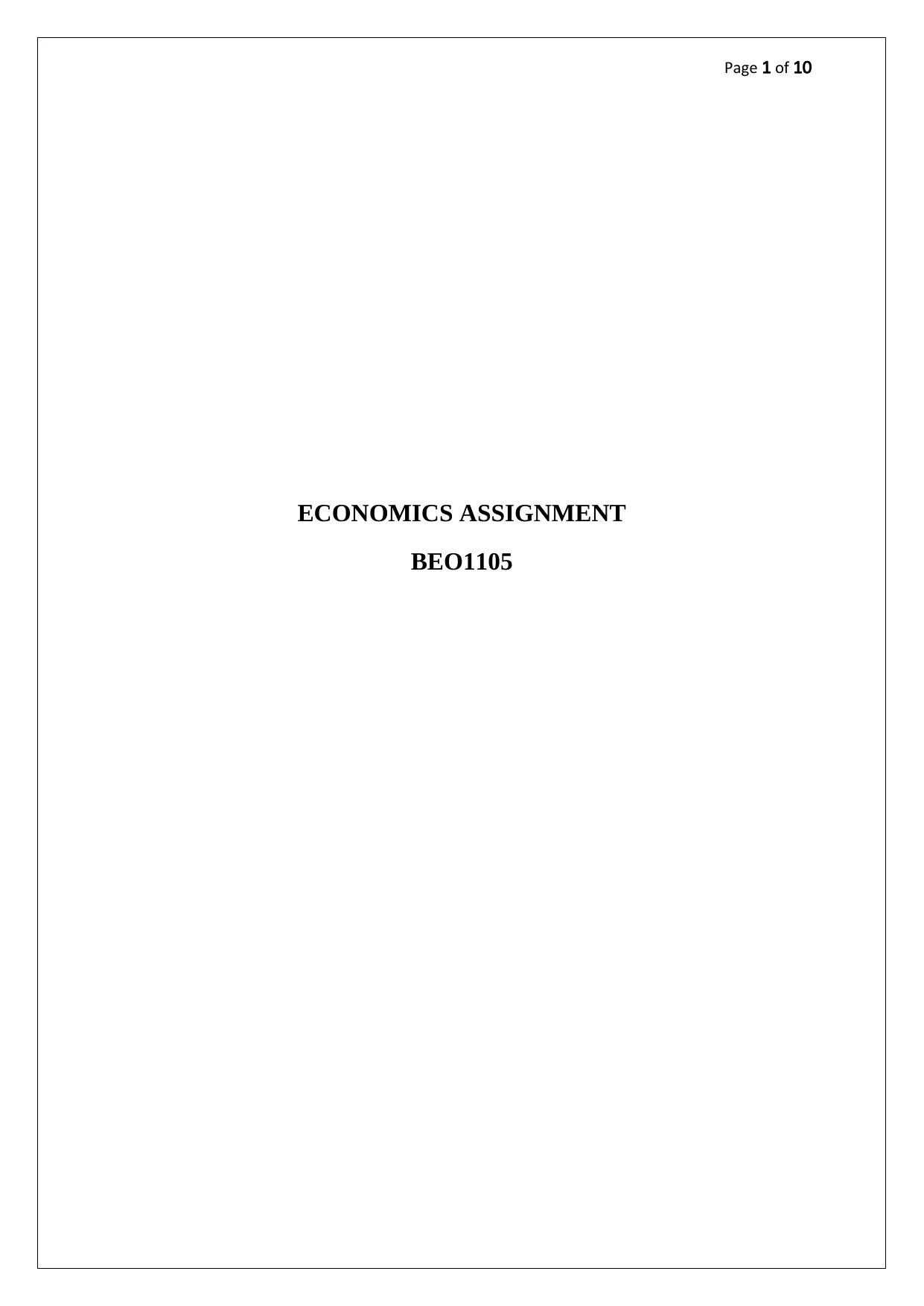
Page 1 of 10
ECONOMICS ASSIGNMENT
BEO1105
ECONOMICS ASSIGNMENT
BEO1105
Paraphrase This Document
Need a fresh take? Get an instant paraphrase of this document with our AI Paraphraser
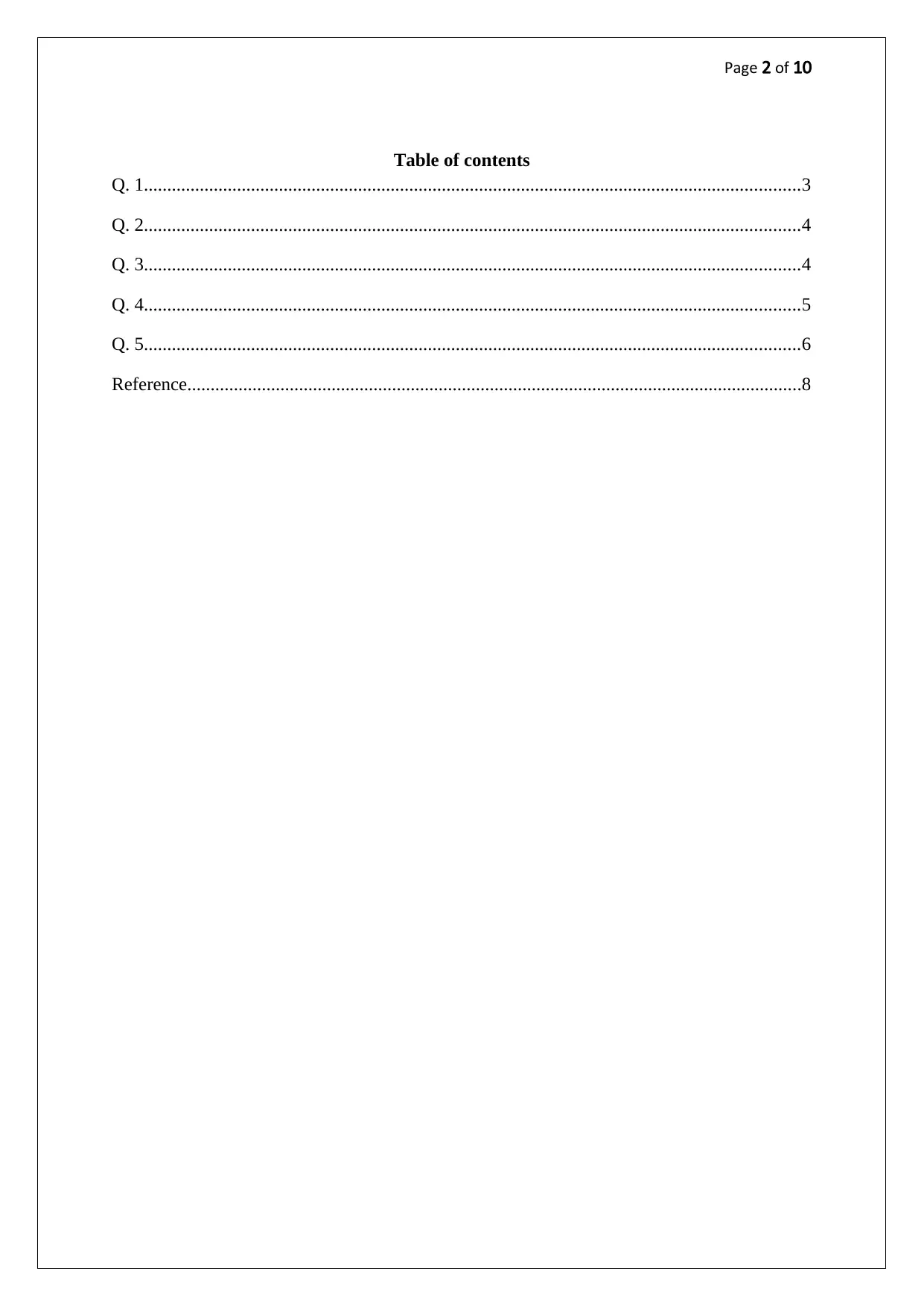
Page 2 of 10
Table of contents
Q. 1.............................................................................................................................................3
Q. 2.............................................................................................................................................4
Q. 3.............................................................................................................................................4
Q. 4.............................................................................................................................................5
Q. 5.............................................................................................................................................6
Reference....................................................................................................................................8
Table of contents
Q. 1.............................................................................................................................................3
Q. 2.............................................................................................................................................4
Q. 3.............................................................................................................................................4
Q. 4.............................................................................................................................................5
Q. 5.............................................................................................................................................6
Reference....................................................................................................................................8
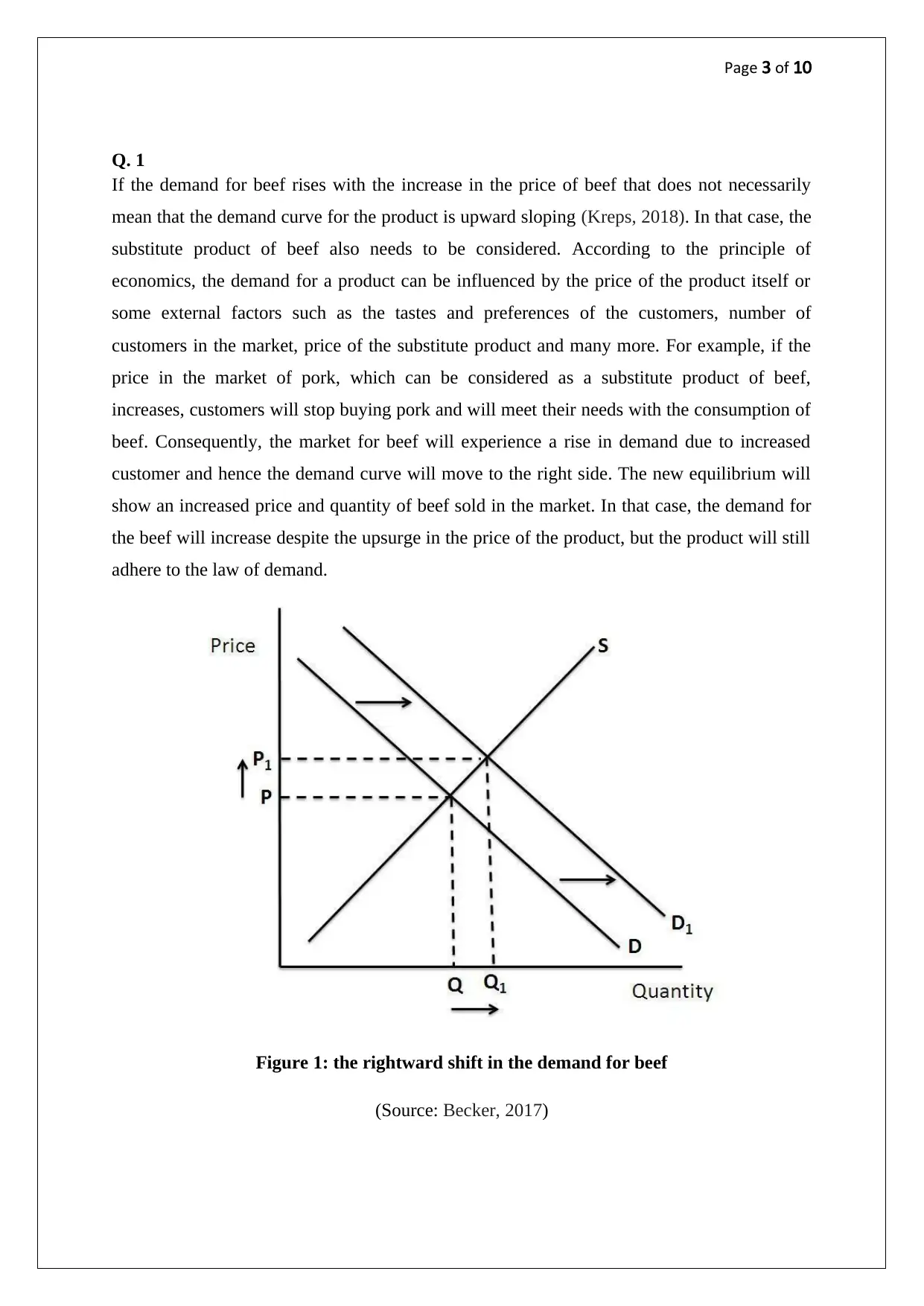
Page 3 of 10
Q. 1
If the demand for beef rises with the increase in the price of beef that does not necessarily
mean that the demand curve for the product is upward sloping (Kreps, 2018). In that case, the
substitute product of beef also needs to be considered. According to the principle of
economics, the demand for a product can be influenced by the price of the product itself or
some external factors such as the tastes and preferences of the customers, number of
customers in the market, price of the substitute product and many more. For example, if the
price in the market of pork, which can be considered as a substitute product of beef,
increases, customers will stop buying pork and will meet their needs with the consumption of
beef. Consequently, the market for beef will experience a rise in demand due to increased
customer and hence the demand curve will move to the right side. The new equilibrium will
show an increased price and quantity of beef sold in the market. In that case, the demand for
the beef will increase despite the upsurge in the price of the product, but the product will still
adhere to the law of demand.
Figure 1: the rightward shift in the demand for beef
(Source: Becker, 2017)
Q. 1
If the demand for beef rises with the increase in the price of beef that does not necessarily
mean that the demand curve for the product is upward sloping (Kreps, 2018). In that case, the
substitute product of beef also needs to be considered. According to the principle of
economics, the demand for a product can be influenced by the price of the product itself or
some external factors such as the tastes and preferences of the customers, number of
customers in the market, price of the substitute product and many more. For example, if the
price in the market of pork, which can be considered as a substitute product of beef,
increases, customers will stop buying pork and will meet their needs with the consumption of
beef. Consequently, the market for beef will experience a rise in demand due to increased
customer and hence the demand curve will move to the right side. The new equilibrium will
show an increased price and quantity of beef sold in the market. In that case, the demand for
the beef will increase despite the upsurge in the price of the product, but the product will still
adhere to the law of demand.
Figure 1: the rightward shift in the demand for beef
(Source: Becker, 2017)
⊘ This is a preview!⊘
Do you want full access?
Subscribe today to unlock all pages.

Trusted by 1+ million students worldwide
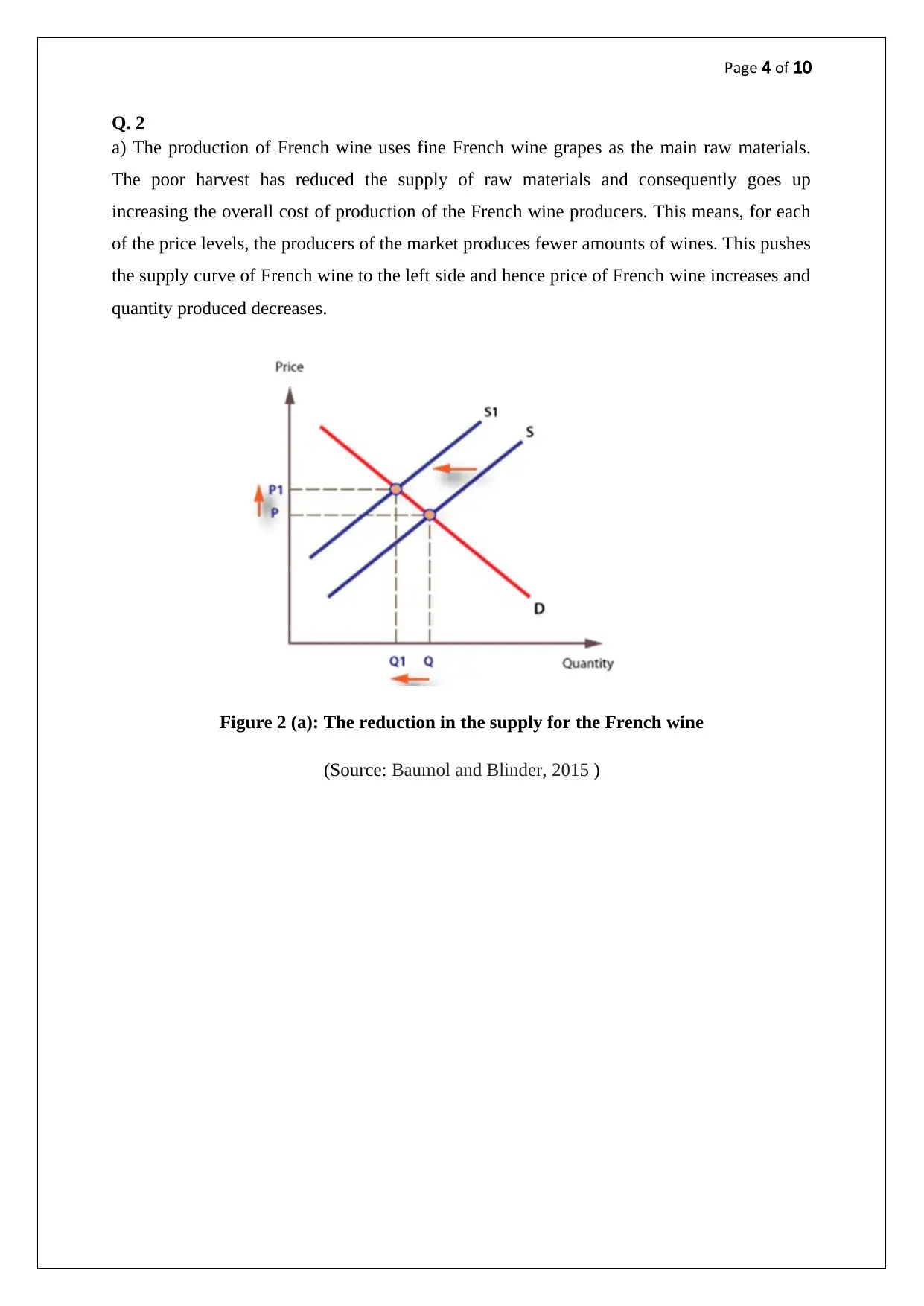
Page 4 of 10
Q. 2
a) The production of French wine uses fine French wine grapes as the main raw materials.
The poor harvest has reduced the supply of raw materials and consequently goes up
increasing the overall cost of production of the French wine producers. This means, for each
of the price levels, the producers of the market produces fewer amounts of wines. This pushes
the supply curve of French wine to the left side and hence price of French wine increases and
quantity produced decreases.
Figure 2 (a): The reduction in the supply for the French wine
(Source: Baumol and Blinder, 2015 )
Q. 2
a) The production of French wine uses fine French wine grapes as the main raw materials.
The poor harvest has reduced the supply of raw materials and consequently goes up
increasing the overall cost of production of the French wine producers. This means, for each
of the price levels, the producers of the market produces fewer amounts of wines. This pushes
the supply curve of French wine to the left side and hence price of French wine increases and
quantity produced decreases.
Figure 2 (a): The reduction in the supply for the French wine
(Source: Baumol and Blinder, 2015 )
Paraphrase This Document
Need a fresh take? Get an instant paraphrase of this document with our AI Paraphraser
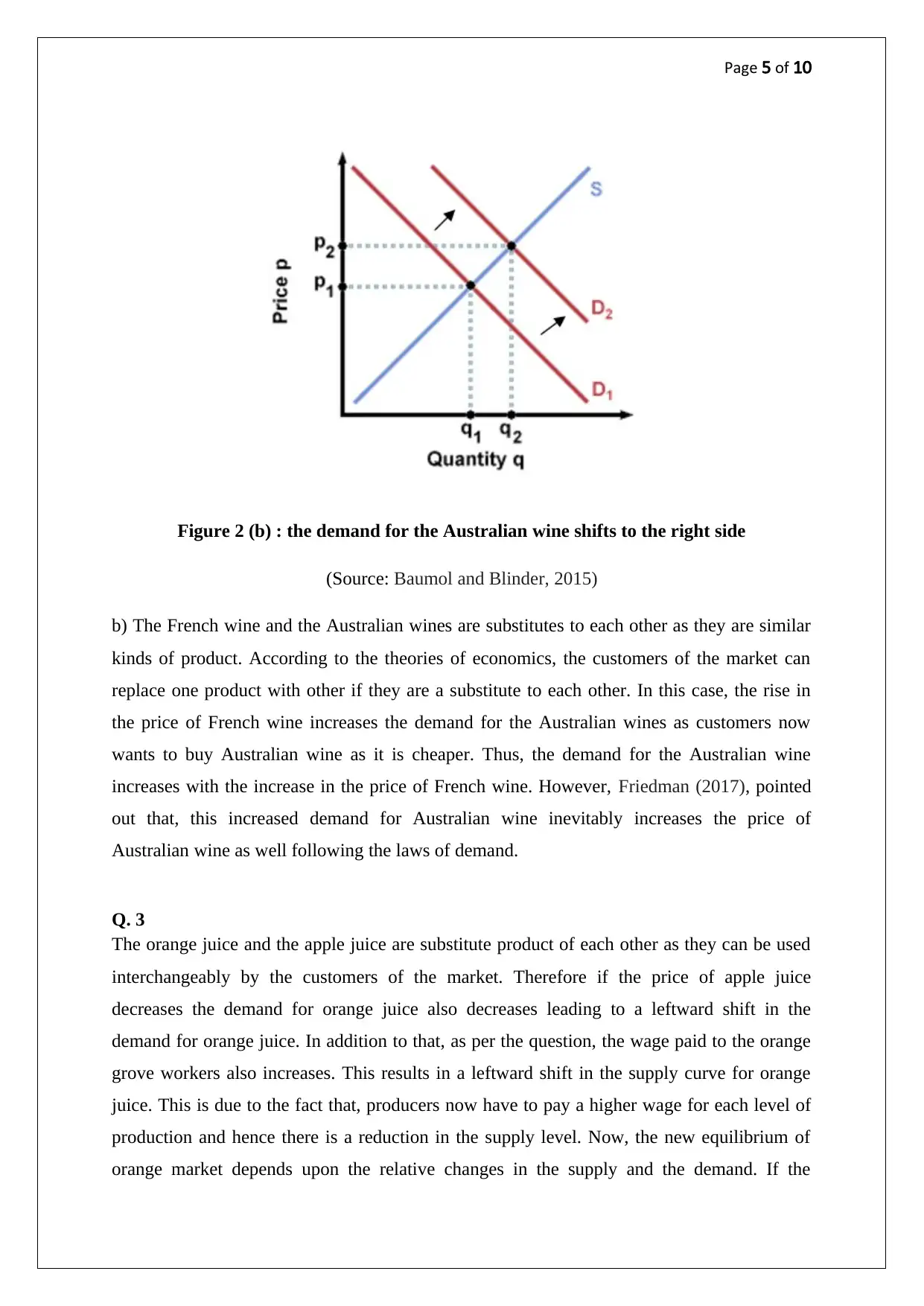
Page 5 of 10
Figure 2 (b) : the demand for the Australian wine shifts to the right side
(Source: Baumol and Blinder, 2015)
b) The French wine and the Australian wines are substitutes to each other as they are similar
kinds of product. According to the theories of economics, the customers of the market can
replace one product with other if they are a substitute to each other. In this case, the rise in
the price of French wine increases the demand for the Australian wines as customers now
wants to buy Australian wine as it is cheaper. Thus, the demand for the Australian wine
increases with the increase in the price of French wine. However, Friedman (2017), pointed
out that, this increased demand for Australian wine inevitably increases the price of
Australian wine as well following the laws of demand.
Q. 3
The orange juice and the apple juice are substitute product of each other as they can be used
interchangeably by the customers of the market. Therefore if the price of apple juice
decreases the demand for orange juice also decreases leading to a leftward shift in the
demand for orange juice. In addition to that, as per the question, the wage paid to the orange
grove workers also increases. This results in a leftward shift in the supply curve for orange
juice. This is due to the fact that, producers now have to pay a higher wage for each level of
production and hence there is a reduction in the supply level. Now, the new equilibrium of
orange market depends upon the relative changes in the supply and the demand. If the
Figure 2 (b) : the demand for the Australian wine shifts to the right side
(Source: Baumol and Blinder, 2015)
b) The French wine and the Australian wines are substitutes to each other as they are similar
kinds of product. According to the theories of economics, the customers of the market can
replace one product with other if they are a substitute to each other. In this case, the rise in
the price of French wine increases the demand for the Australian wines as customers now
wants to buy Australian wine as it is cheaper. Thus, the demand for the Australian wine
increases with the increase in the price of French wine. However, Friedman (2017), pointed
out that, this increased demand for Australian wine inevitably increases the price of
Australian wine as well following the laws of demand.
Q. 3
The orange juice and the apple juice are substitute product of each other as they can be used
interchangeably by the customers of the market. Therefore if the price of apple juice
decreases the demand for orange juice also decreases leading to a leftward shift in the
demand for orange juice. In addition to that, as per the question, the wage paid to the orange
grove workers also increases. This results in a leftward shift in the supply curve for orange
juice. This is due to the fact that, producers now have to pay a higher wage for each level of
production and hence there is a reduction in the supply level. Now, the new equilibrium of
orange market depends upon the relative changes in the supply and the demand. If the
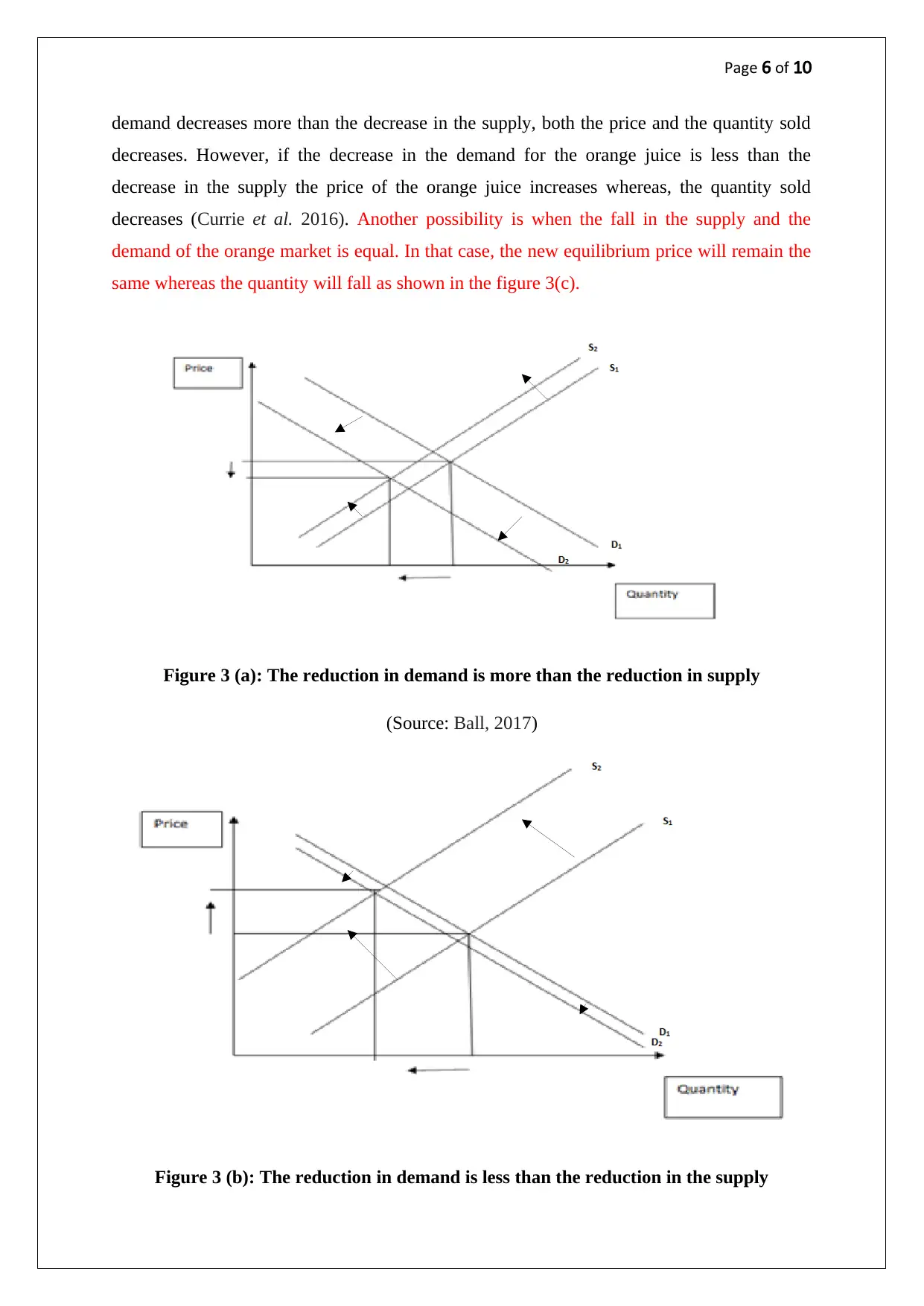
Page 6 of 10
demand decreases more than the decrease in the supply, both the price and the quantity sold
decreases. However, if the decrease in the demand for the orange juice is less than the
decrease in the supply the price of the orange juice increases whereas, the quantity sold
decreases (Currie et al. 2016). Another possibility is when the fall in the supply and the
demand of the orange market is equal. In that case, the new equilibrium price will remain the
same whereas the quantity will fall as shown in the figure 3(c).
Figure 3 (a): The reduction in demand is more than the reduction in supply
(Source: Ball, 2017)
Figure 3 (b): The reduction in demand is less than the reduction in the supply
demand decreases more than the decrease in the supply, both the price and the quantity sold
decreases. However, if the decrease in the demand for the orange juice is less than the
decrease in the supply the price of the orange juice increases whereas, the quantity sold
decreases (Currie et al. 2016). Another possibility is when the fall in the supply and the
demand of the orange market is equal. In that case, the new equilibrium price will remain the
same whereas the quantity will fall as shown in the figure 3(c).
Figure 3 (a): The reduction in demand is more than the reduction in supply
(Source: Ball, 2017)
Figure 3 (b): The reduction in demand is less than the reduction in the supply
⊘ This is a preview!⊘
Do you want full access?
Subscribe today to unlock all pages.

Trusted by 1+ million students worldwide
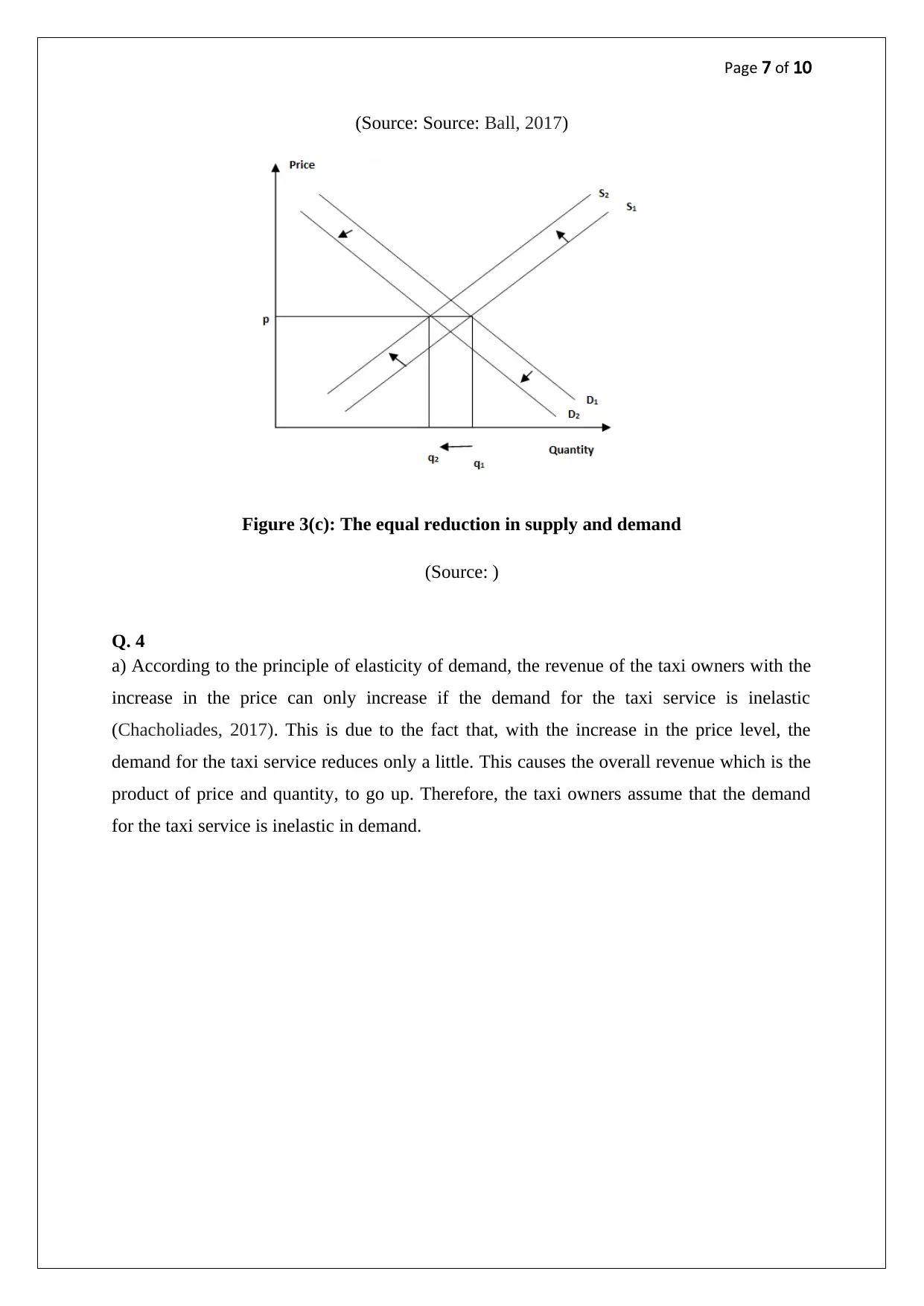
Page 7 of 10
(Source: Source: Ball, 2017)
Figure 3(c): The equal reduction in supply and demand
(Source: )
Q. 4
a) According to the principle of elasticity of demand, the revenue of the taxi owners with the
increase in the price can only increase if the demand for the taxi service is inelastic
(Chacholiades, 2017). This is due to the fact that, with the increase in the price level, the
demand for the taxi service reduces only a little. This causes the overall revenue which is the
product of price and quantity, to go up. Therefore, the taxi owners assume that the demand
for the taxi service is inelastic in demand.
(Source: Source: Ball, 2017)
Figure 3(c): The equal reduction in supply and demand
(Source: )
Q. 4
a) According to the principle of elasticity of demand, the revenue of the taxi owners with the
increase in the price can only increase if the demand for the taxi service is inelastic
(Chacholiades, 2017). This is due to the fact that, with the increase in the price level, the
demand for the taxi service reduces only a little. This causes the overall revenue which is the
product of price and quantity, to go up. Therefore, the taxi owners assume that the demand
for the taxi service is inelastic in demand.
Paraphrase This Document
Need a fresh take? Get an instant paraphrase of this document with our AI Paraphraser
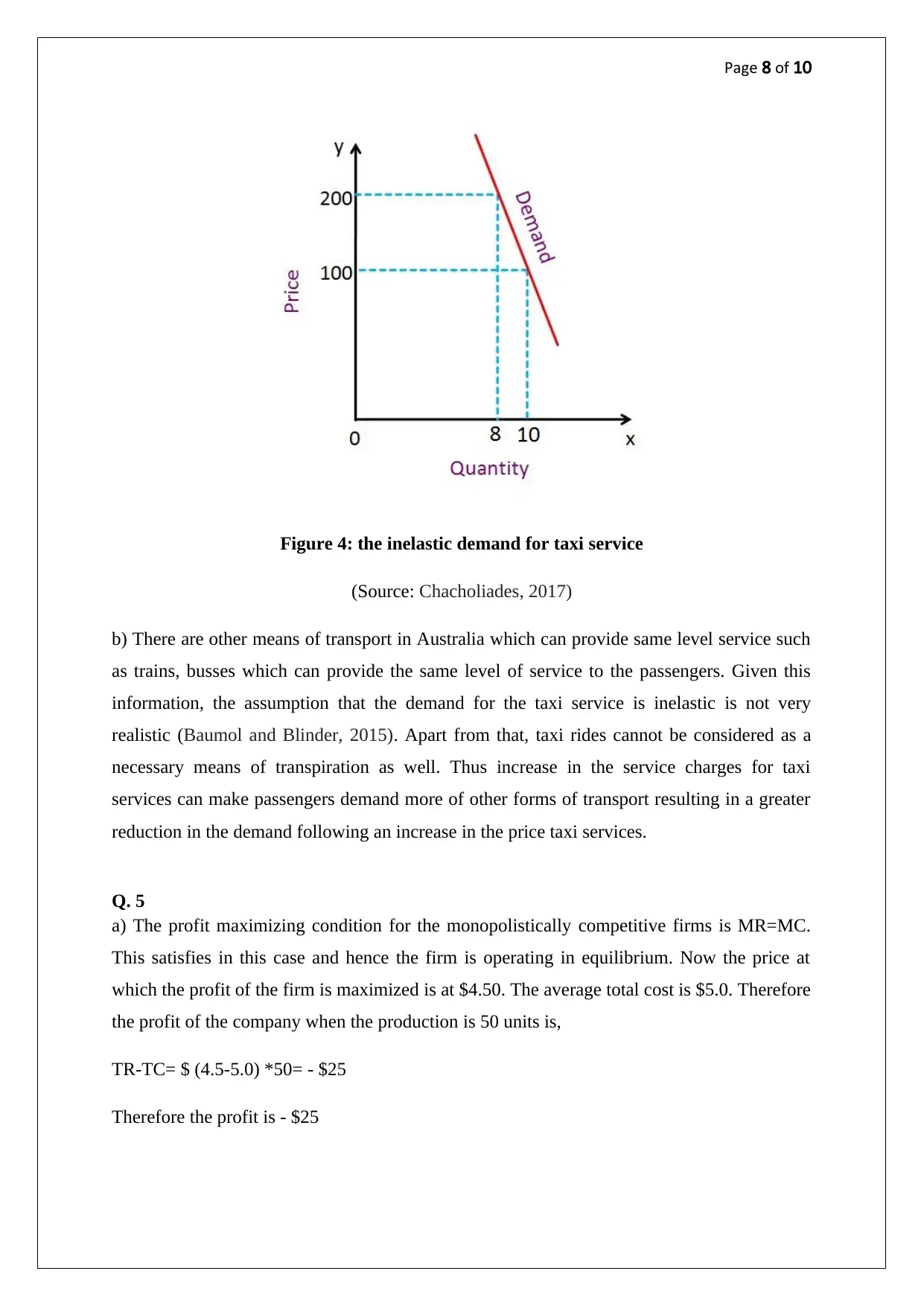
Page 8 of 10
Figure 4: the inelastic demand for taxi service
(Source: Chacholiades, 2017)
b) There are other means of transport in Australia which can provide same level service such
as trains, busses which can provide the same level of service to the passengers. Given this
information, the assumption that the demand for the taxi service is inelastic is not very
realistic (Baumol and Blinder, 2015). Apart from that, taxi rides cannot be considered as a
necessary means of transpiration as well. Thus increase in the service charges for taxi
services can make passengers demand more of other forms of transport resulting in a greater
reduction in the demand following an increase in the price taxi services.
Q. 5
a) The profit maximizing condition for the monopolistically competitive firms is MR=MC.
This satisfies in this case and hence the firm is operating in equilibrium. Now the price at
which the profit of the firm is maximized is at $4.50. The average total cost is $5.0. Therefore
the profit of the company when the production is 50 units is,
TR-TC= $ (4.5-5.0) *50= - $25
Therefore the profit is - $25
Figure 4: the inelastic demand for taxi service
(Source: Chacholiades, 2017)
b) There are other means of transport in Australia which can provide same level service such
as trains, busses which can provide the same level of service to the passengers. Given this
information, the assumption that the demand for the taxi service is inelastic is not very
realistic (Baumol and Blinder, 2015). Apart from that, taxi rides cannot be considered as a
necessary means of transpiration as well. Thus increase in the service charges for taxi
services can make passengers demand more of other forms of transport resulting in a greater
reduction in the demand following an increase in the price taxi services.
Q. 5
a) The profit maximizing condition for the monopolistically competitive firms is MR=MC.
This satisfies in this case and hence the firm is operating in equilibrium. Now the price at
which the profit of the firm is maximized is at $4.50. The average total cost is $5.0. Therefore
the profit of the company when the production is 50 units is,
TR-TC= $ (4.5-5.0) *50= - $25
Therefore the profit is - $25
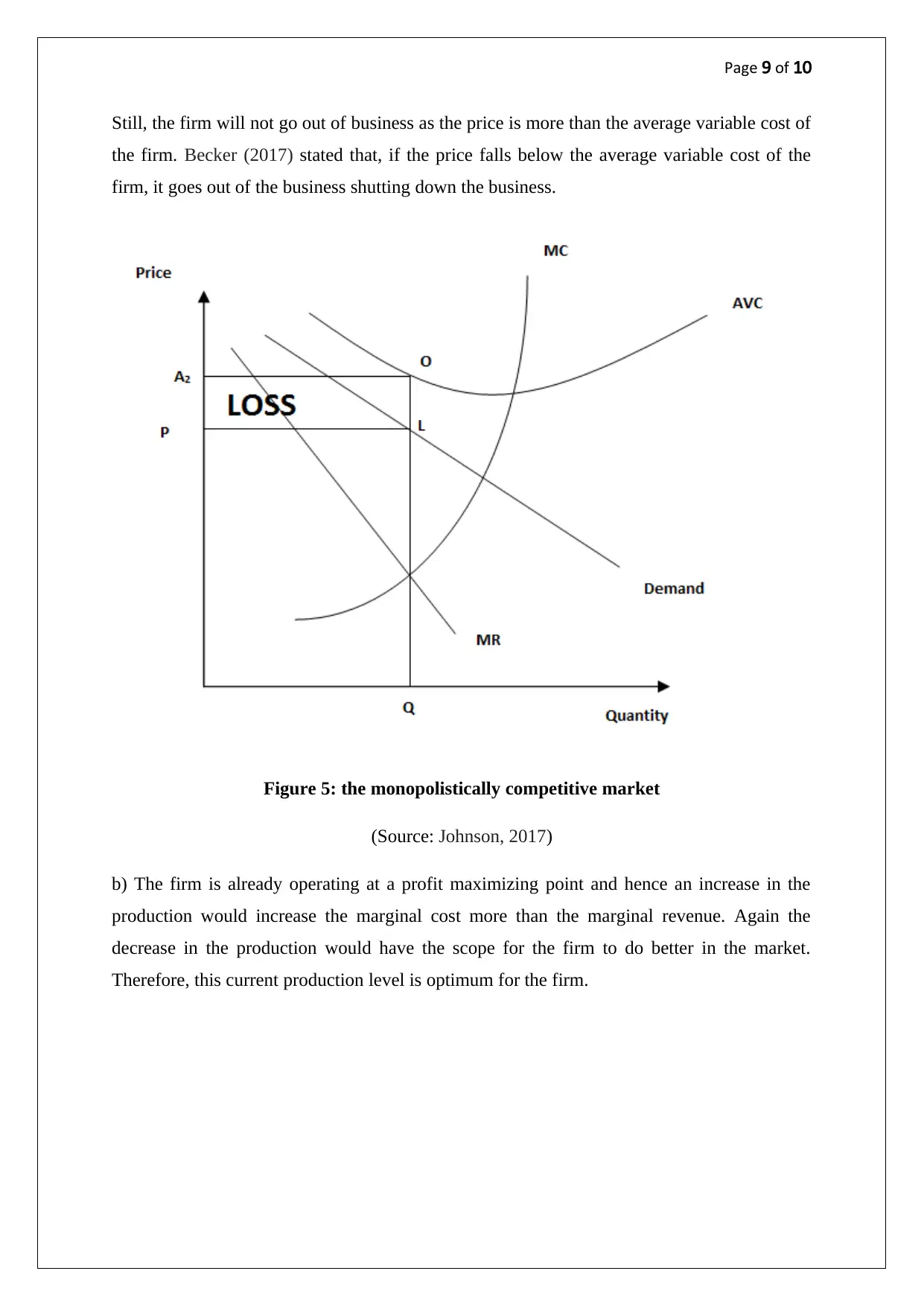
Page 9 of 10
Still, the firm will not go out of business as the price is more than the average variable cost of
the firm. Becker (2017) stated that, if the price falls below the average variable cost of the
firm, it goes out of the business shutting down the business.
Figure 5: the monopolistically competitive market
(Source: Johnson, 2017)
b) The firm is already operating at a profit maximizing point and hence an increase in the
production would increase the marginal cost more than the marginal revenue. Again the
decrease in the production would have the scope for the firm to do better in the market.
Therefore, this current production level is optimum for the firm.
Still, the firm will not go out of business as the price is more than the average variable cost of
the firm. Becker (2017) stated that, if the price falls below the average variable cost of the
firm, it goes out of the business shutting down the business.
Figure 5: the monopolistically competitive market
(Source: Johnson, 2017)
b) The firm is already operating at a profit maximizing point and hence an increase in the
production would increase the marginal cost more than the marginal revenue. Again the
decrease in the production would have the scope for the firm to do better in the market.
Therefore, this current production level is optimum for the firm.
⊘ This is a preview!⊘
Do you want full access?
Subscribe today to unlock all pages.

Trusted by 1+ million students worldwide
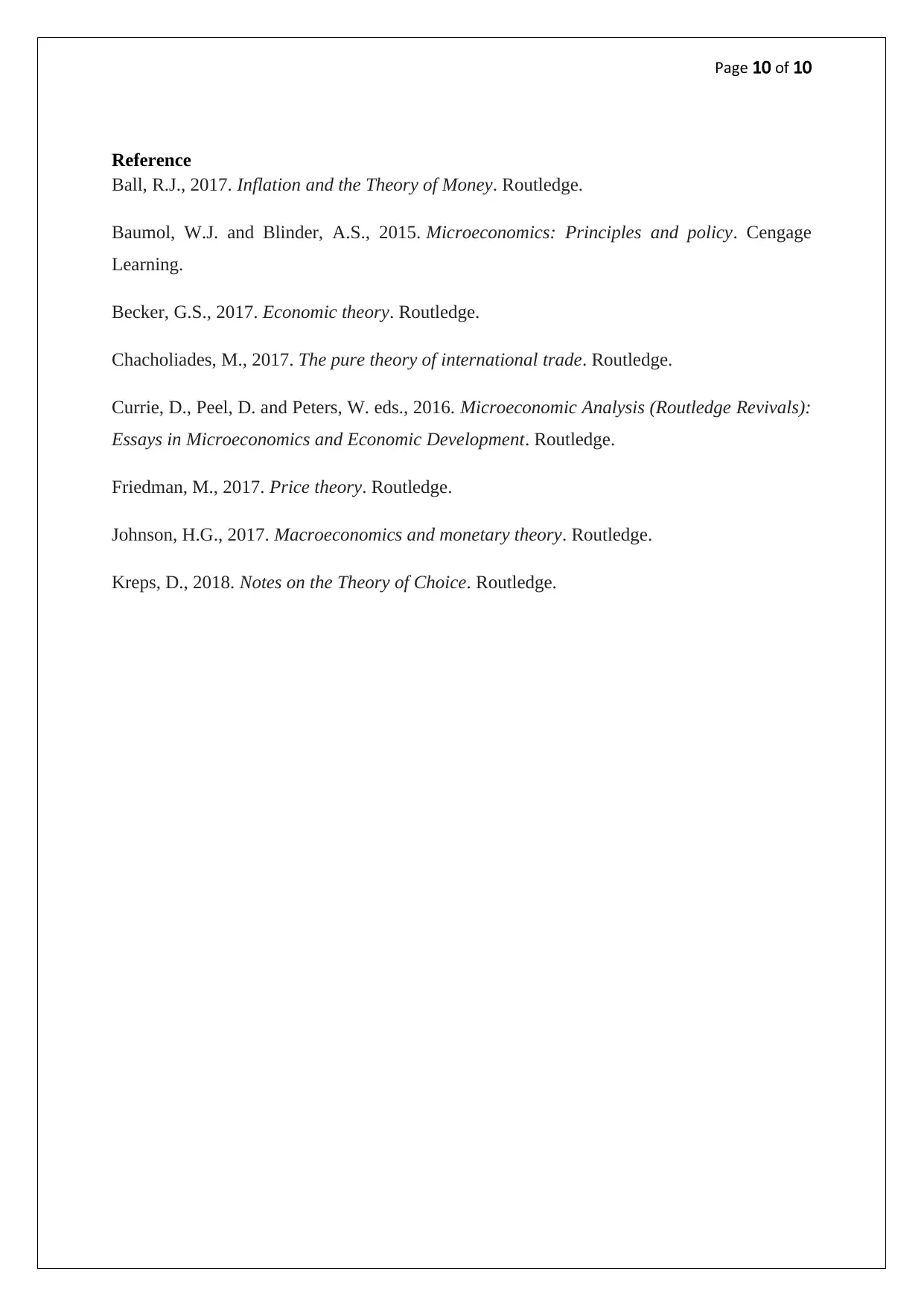
Page 10 of 10
Reference
Ball, R.J., 2017. Inflation and the Theory of Money. Routledge.
Baumol, W.J. and Blinder, A.S., 2015. Microeconomics: Principles and policy. Cengage
Learning.
Becker, G.S., 2017. Economic theory. Routledge.
Chacholiades, M., 2017. The pure theory of international trade. Routledge.
Currie, D., Peel, D. and Peters, W. eds., 2016. Microeconomic Analysis (Routledge Revivals):
Essays in Microeconomics and Economic Development. Routledge.
Friedman, M., 2017. Price theory. Routledge.
Johnson, H.G., 2017. Macroeconomics and monetary theory. Routledge.
Kreps, D., 2018. Notes on the Theory of Choice. Routledge.
Reference
Ball, R.J., 2017. Inflation and the Theory of Money. Routledge.
Baumol, W.J. and Blinder, A.S., 2015. Microeconomics: Principles and policy. Cengage
Learning.
Becker, G.S., 2017. Economic theory. Routledge.
Chacholiades, M., 2017. The pure theory of international trade. Routledge.
Currie, D., Peel, D. and Peters, W. eds., 2016. Microeconomic Analysis (Routledge Revivals):
Essays in Microeconomics and Economic Development. Routledge.
Friedman, M., 2017. Price theory. Routledge.
Johnson, H.G., 2017. Macroeconomics and monetary theory. Routledge.
Kreps, D., 2018. Notes on the Theory of Choice. Routledge.
1 out of 10
Related Documents
Your All-in-One AI-Powered Toolkit for Academic Success.
+13062052269
info@desklib.com
Available 24*7 on WhatsApp / Email
![[object Object]](/_next/static/media/star-bottom.7253800d.svg)
Unlock your academic potential
Copyright © 2020–2025 A2Z Services. All Rights Reserved. Developed and managed by ZUCOL.



